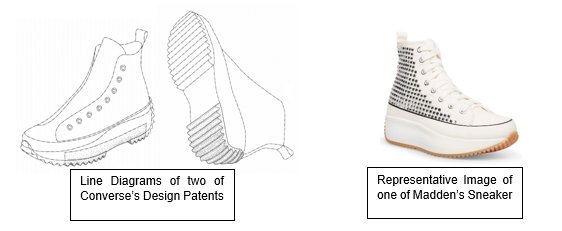The fifth generation of wireless technology (5G) is a transformative leap in mobile communications. This…
Converse Wins Shoe Design Patent Claim against Steve Madden
Recently, the United States District Court of Massachusetts denied Steve Madden’s petition to dismiss part of the design patent infringement claim raised by Converse Inc. Steve Madden (“Madden”) is a major manufacturer and retailer of apparel, footwear, belts, handbags, and accessories, while Converse Inc., (“Converse”) is a major footwear company.
Converse introduced its “Run Star Hike” sneaker in London in 2018 and released it for sale in the United States in 2019. Converse has filed applications and obtain patents related to the design of that sneaker, including U.S. Design Patent Nos. D873,547 (“the ‘547 Patent”) and D874,106 (“the ‘106 Patent”).
In early 2020, Madden began selling two brands of sneakers among others, namely, “the Madden Girl Winnona Flatform HighTop Sneaker” (“the Winnona Sneaker”) and the “Shark Sneaker.” Converse felt these two Madden’s sneakers were very similar to their above-mentioned designs, and therefore notified Madden on three separate occasions in March, April, and May 2020 that, in its opinion, the Winnona and Shark Sneakers infringe on the ‘547 and ‘106 Patents and to cease and desist from such infringement. Madden refused and continued to sell the purportedly infringing sneakers.
Converse thereafter filed a suit in May 2020, asserting two counts against Madden for infringement of the ‘106 Patent by the Winnona and Shark Sneakers (Count I) and infringement of the ‘547 Patent by the Shark Sneaker (Count II). Madden seeks dismissal of Count I as it relates to the Winnona Sneaker. In this, Converse argued that the patent infringement claim is facially implausible because the tread design on the sole of the Winnona Sneaker, which extends the full length of the shoe, cannot infringe on the substantially different tread design claimed in the ‘106 Patent because the latter covers only the rear portion of the sole. Converse further responded that it is premature to presume the necessary claim construction and, in any event, Madden has presented no evidence to establish that the claimed and accused designs are clearly dissimilar.
The parties have provided illustrations of the ‘106 Patent and photographs of the allegedly infringing Winnona sneaker in the complaint and the pleadings related to the instant motion. Comparing those images side-by-side, the Court observed that the two designs are not “plainly dissimilar” to the point of warranting dismissal of Converse’s claims. Instead, it is possible that an ordinary consumer would be confused or deceived into believing that the accused product is the patented design. The patent illustration and the Winnona sneaker are virtually identical in many ways, including with respect to the rear sole tread pattern which constitutes the plaintiff’s claimed design. The only obvious difference between the two designs is that the tread pattern extends the full length of the Winnona sneaker while the tread pattern is missing from the middle of the sole in the ‘106 Patent.
Based on the above, the District Court denied the motion filed by Steve Madden to dismiss part (Count I) of the design patent infringement claim raised by Converse Inc.
Author: Arindam Purkayastha, a patent attorney at IIPRD. In case of any queries please contact/write back to us at arindam@iiprd.com.



